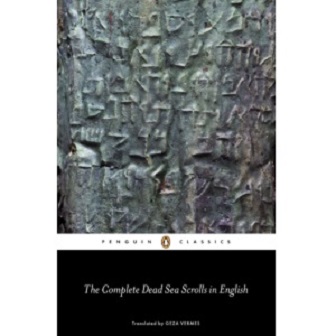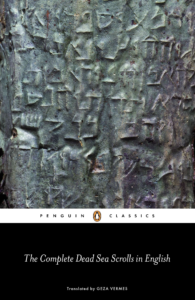Geza Vermes (pronounced ver-mesh) was a leading scholar on the Dead Sea Scrolls and among the first to examine them. He translated them into English in 1962. It is his translation that is found here in The Complete Dead Sea Scrolls in English.
The Complete Dead Sea Scrolls in English
Geza Vermes
Penguin Classics; 7th edition
June 26, 2012
Geza Vermes’ translation of the Dead Sea Scrolls is considered to be one of the best, if not the best. There are always challenges in going from one language to another, and Vermes handles this masterfully. The text of The Complete Dead Sea Scrolls in English is a literal translation, yet very readable. Like a good literal Bible translation (ESV, NASB, NKJV), the Hebrew and Aramaic word order is sometimes altered so that it makes sense in English. The result, according to the translation notes, is something that “aims at being faithful, intelligible and as far as possible readable.”
The title of the book is “The Complete Dead Sea Scrolls…” however, the collection of “scrolls” is anything but complete. Many of them exist only in fragments. The preface states, “this translation… is complete in one sense: it offers in a readable form all the texts sufficiently well preserved to be understandable in English… meaningless scraps or badly damaged manuscript sections are not inflicted on the reader.”
The Complete Dead Sea Scrolls in English also does not include include Biblical Scripture texts. It is said that all but one of the 24 books (39 in Christian Bibles) of the Tanakh or Old Testament are found at least in part in the Dead Sea Scrolls, the exception being the book of Esther. For a good, assembled translation of the Biblical texts, see The Dead Sea Scrolls Bible by Martin Abegg, Jr., Peter Flint, and Eugene Ulrich. Vermes recommends this volume in his work, which he calls “the non-biblical Dead Sea Scrolls.”
Content of the Dead Sea Scrolls
Vermes has organized the “scrolls” into topics, and not necessarily where (in what caves) the scrolls were found. This makes better sense for the reader, as sometimes partial scrolls for the same “book” were found at different locations. The translation notes say, “when the same writing is extant in several manuscripts, the translation either represents a composite text, or indicates variants, but identical passages are not normally repeated.”
Lacunae (plural – unfilled spaces, intervals, or gaps; missing portions in manuscripts) “impossible to complete with any measure of confidence are indicated by dots in the translation. Texts supplied from a different manuscript of the same document appear between{}.” So to some extent, as it is with nearly every ancient document including both Old and New Testament Biblical texts, these are composite texts.
Vermes categorizes the scrolls into eight general groups consisting of more than 150 texts:
- The Rules (31)
- Hymns and Poems (10)
- Calendars, Liturgies and Prayers (22)
- Historical and Apocalyptic Works (8)
- Wisdom Literature (14)
- Bible Interpretation (26)
- Biblically Based Apocryphal Works (41)
- Miscellanea (3)
Besides the neo-Biblical content, these scrolls provide insight into life within the Qumran community. For the general reader without the full context or at least a basic understanding of the culture, reading the content of these individual scrolls could be very confusing or, worse yet, lead to some aberrant doctrine, understanding, or practice. That is where the value of Geza Vermes’ scholarly insight shines.
And so this leads to a very important part of The Complete Dead Sea Scrolls in English, simply called the “Introduction.” If you never actually read his translation of the scrolls themselves, you should consider obtaining this book simply for the lengthy introduction. Here, Vermes offers a concise but thorough overview of the intertestamental period. Some of it might make both Christians and Jews uncomfortable.
The Introduction
Before presenting introductory material, the author gives a chronology of events in Jerusalem and the middle east from 197 BCE to 135 CE. It includes people and events of religious, social, and political significance.
Vermes then continues with an overview of the discovery and research into the Dead Sea Scrolls. His presentation is well documented, with more than 70 footnotes/endnotes just in the 90-page introduction. He includes numerous references not only to passages in the Dead Sea Scrolls but also to the apocryphal books of Maccabees, works of the the Jewish historian Josephus, and others
Included in the introduction is a detailed explanation of life within the Qumran community, and particularly the events of the intertestamental period that led up to this group parting ways with the politically-influenced and Hellenized religious leaders at the Temple in Jerusalem.
Here is a more detailed breakdown of the Introduction to The Complete Dead Sea Scrolls In English.
- Introduction
- A chronology from BCE 197 to 135 CE
- A Bird’s-eye View of Fifty Years of Dead Sea Scrolls Research
- 1947-1967
- 1967-1990
- 1990-2003
- The Present State of Dead Sea Scrolls Studies
- The Dating of the Manuscripts
- The Provenance of the Manuscripts
- The Significance of the Qumran Scrolls
- Qumran and the New Testament
- Qumran’s Greatest Novelty
- The Community
- The Essenes and the Qumran Community
- The Essenes
- Essenes and Qumran
- The Essenes and the Qumran Community
- The History of the Community
- Inter-Testamental Jewish History: 200 BCE – 70 CE
- The History of the Essenes
- Concealed References in the Scrolls
- The Chronological Framework
- Decipherment of Particular Allusions
- The Religious Ideas of the Community
- The Covenant
- Election and Holy Life in the Community of the Covenant
- Worship in the Community of the Covenant
- Future Expectations in the Community of the Covenant
Format
This book is in single column format (at least my copy, the 2004 Revised Edition – other editions could be different). You will encounter bracketing of various forms throughout, as some of the text is incomplete. Designations indicating the columns in the original scrolls are embedded in the text, which are helpful in locating lines if you have other resources that make reference to Dead Sea Scrolls content. Not unlike many study Bibles, these kinds of things sometimes get in the way of general reading.
In each section and before the text of the scrolls, the author gives a brief overview of the history, use, and content.
Reading the actual translation of the scrolls requires some concentration. The reading level is described as “age 18 and up” or “grade 12 and up.” It is modern English, but on a very academic level, making it easy to miss things if there are distractions. And I must confess, I have not read all of the Dead Sea Scrolls content. It is good reference material, and again, the Introduction is great.
The current Penguin Classics Seventh Edition (2012) is in paperback; my previous edition is hardback. You may be able to find earlier editions in various bindings, but the content of the scrolls and introductory material should be the same. I found the page layout itself very comfortable.
All of the abbreviations used are listed in one place, and there are many. I did find myself referring back to the list frequently, though at times I just skipped by them if they didn’t remember them and they didn’t seem that important at the time. There is an extensive bibliography, a catalog of all the texts, and an index.
For anyone interested in intertestamental history, The Complete Dead Sea Scrolls in English by Geza Vermes will be an invaluable resource.


